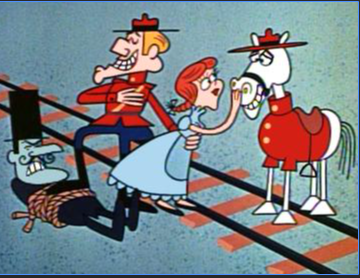You don’t need to write a doctoral dissertation on “The Art Of War” by Sun Tzu to understand that underestimating your enemy is very, very bad.
Yet our society breeds us to look at a very bipolar world. The good guys vs. the bad guys. Good vs. Evil. God vs. the Devil.

Western movies featured the good guys vs. the bad guys. The good guys were easy to recognize, they all wore white. The bad guys, villains, always wore black. In shorthand they called them the white hats and the black hats. Those terms have carried over today — for example hackers are known as white hat or black hat depending upon their motives. In melodrama it was common to have a villain as personified by Snidely Whiplash, who would abduct a damsel and tie her to the railroad tracks.
And then of course there is the field of sports. Probably the biggest influence in society. We have team rivalries, and we have a die-hard fans. The home team is the good guys, and the visiting team is the bad guys. If you don’t think these things go to extremes, you have never heard of the riots at soccer matches in South America or Europe, and the clashes at Major League sports in American sports arenas. We even have violence in little leagues when berserk parents and misguided coaches, supposedly adults, violently clash.
And of course many people were raised with an appreciation for comic books. In this non-literate age, most of that has been assumed by movies and TV. Superhero stories usually featured the absolutely honest and virtuous hero fighting an evil, monstrous villain.
Now we know that it isn’t quite that clear-cut in real life. The bipolar world has black and white, real life has shades of grey.
What is missing here?
Motive.
Why would snidely whiplash tie Sweet Nell to the railroad tracks? Why would Lex Luthor try to kill Superman with Kryptonite? Why do any of the awesomely deranged and costumed villains Spider-Man faces want to rule the world or even destroy the world? And look at the James Bond stories — at least in the beginning they started out as a succession of mad men bent on world domination.
What we see in our society today has been shaped by our upbringing. Especially in an election year, which is every two years, we have a bipolar two party system.
To Old-Timers it feels like things have gotten more and more personal and violent in the past few decades. One would think that in the good old days there was more of a rivalry between political parties where one respectable opponent would meet another respectable opponent for a civilized debate and discourse, and allow the public to decide on the facts. That is why we never really have had one party dominate for long periods of time. The biggest exception would be during FDR during the great depression, the only time we have ever had a president in office for four terms.
Now the political parties view each other as evil. One party’s “GOOD” is the other party’s “EVIL” and vice-versa, depending upon your point of view. Rather than just having a disagreement with your opponent, you cast that opponent as evil, justifying the commission of evil acts to vanquish that opponent.
But in real life and in the better forms of literature, the so-called bad guys have motives for what they do. They can justify the most outrageous actions to themselves. And in fact they may have the best intentions in the world.
Yes I know, the road to hell is paved with good intentions.
But the world takes on an entirely different light if we try to analyze what the motives are for the people that we think are evil.
Yes people do certain things to achieve certain ends. For example one person may have a grand idea for reshaping the economy for the benefit of all humanity. And that person may be cast as evil by the people who do not want fairness and equality, who want to be the top of the pyramid.
Eugenics, ethnic cleansing, genocide — humans have justified all of these things in various places and times.
So when we see somebody doing things with which we don’t agree, or don’t like, we should try to ferret out the motives.
Today we have a post-information age, perhaps mis-information age. So many things are cast as the truth, and yet so many are conflicting. Every side can justify calling their opponents “Fake News.”
Money is power and power is money. This explains a lot. After the Watergate scandal, a phrase from that era has survived — “follow the money.”
That’s why we have propaganda wars, where whole societies are shaped by the news that they receive.
However in our post-information age, our mis-information age, news does not rise to the top on its own merits (i.e. “truth”). The accepted story is the one that the most people like.
Since more people get their news from social media than from the traditional mainstream media, everything is driven by likes and clicks and retweets and forwards.
There is an old song, “Look for the Silver Lining”. In this day and age we need to look for the hidden motive.
Have you ever heard the quote, “Everything you know is wrong?”
What if that is true?
Every once in awhile we should just stop, look, and listen, and try to see the other side.
It may be evil, or it may make perfect sense.
The real problem is it is so easy to “play” people, and a skillful persuader can keep them from even knowing that they have all been played.
You must always seek the “WHY” of things — the motive.
